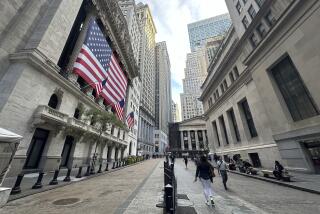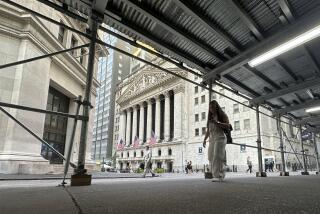Dow closes above 25,000 for the first time
The Dow Jones industrial average closed above the 25,000-point mark Thursday, just five weeks after its first close above 24,000.
The Dow broke past five 1,000-point barriers in 2017 on its way to a 25% gain for the year, as an eight-year rally since the Great Recession continued to confound skeptics.
Strong global economic growth and good prospects for higher company earnings have analysts predicting more gains, although the market may not stay as calm as it has been recently.
The Dow has made a rapid trip since it reached 24,000 points Nov. 30, partly on enthusiasm over passage of the Republican-backed tax package, which could boost company profits this year with across-the-board cuts to corporate taxes.
“For a long while in 2017 I would say the biggest driver was excitement and anticipation over tax reform, but at a certain point I think there was a handover to global economic growth really helping to carry the stock market,” Invesco Chief Global Markets Strategist Kristina Hooper said.
Big gains by U.S. blue-chip companies have powered the Dow’s relentless rise to new heights over the last year, including an 87% gain by aerospace giant Boeing, a 70% rise by construction equipment maker Caterpillar and a 49% increase by Apple.
The Dow, which was founded in 1896 and is the oldest barometer of the U.S. stock market, has nearly quadrupled in value from its low during the financial crisis in early 2009. But the global economy and spending by people and businesses and governments have been much slower to recover than stocks were.
“Instead of fiscal stimulus, we relied on monetary policy stimulus, which inflates asset prices as opposed to the overall economy,” Hooper said. Stocks have continued to climb as investors saw signs that economic growth was finally improving.
Technology companies, which put up some of the biggest gains in the last year, continued to lead the market higher. And there was more good economic news Thursday: A report showed private U.S. businesses added 250,000 jobs last month, with smaller businesses adding 94,000.
The Dow, which tracks 30 big U.S. companies, rose 152.45 points, or 0.6%, to 25,075.13.
The Standard & Poor’s 500, a much broader index that professional investors prefer to use as their benchmark for large U.S. stocks, rose 10.93 points, or 0.4%, to 2,723.99.
The Nasdaq composite, which is heavily weighted with technology and biotech companies, advanced 12.38 points, or 0.2%, to 7,077.91. All three indexes also set record highs a day earlier.
The Nasdaq reached a milestone of its own this week, closing above 7,000 points for the first time Tuesday.
Indexes in some developing countries have done even better than those in Europe and the U.S over the last year. Brazil’s benchmark Bovespa is up 28%, and the Hang Seng index in Hong Kong is up 39%.
Bond prices fell, sending yields higher. The yield on the 10-year Treasury note rose to 2.45% from 2.44%. Higher bond yields are good news for banks because they can charge higher interest rates on mortgages and other kinds of loans.
President Trump said Thursday that the Dow could reach 30,000, which would take an additional 20% jump. Few on Wall Street expect stocks to climb that much any time soon. Stocks already did far better than most observers expected last year, and corporate earnings aren’t rising fast enough to justify that kind of climb.
It wasn’t all rosy Thursday. Intel continued to stumble after security researchers at Google and a group of academic institutions discovered serious security flaws in its computer processors. It fell 1.8% to $44.43 after Wednesday’s 3.4% decline. Intel said it’s working to fix the problem and that it’s not the only company affected.
Benchmark U.S. crude rose 38 cents to $62.01 a barrel. Brent crude, used to price international oils, rose 23 cents to $68.07 a barrel. Wholesale gasoline rose 1 cent to $1.81 a gallon. Heating oil fell 1 cent to $2.08 a gallon. Natural gas plunged 13 cents, or 4.3%, to $2.88 per 1,000 cubic feet.
Gold rose $3.10 to $1,321.60 an ounce. Silver stayed at $17.27 an ounce. Copper rose 1 cent to $3.26 a pound.
The dollar rose to 112.74 yen from 112.52 yen. The euro climbed to $1.2072 from $1.2018.
In overseas markets, France’s CAC 40 and Germany’s DAX each leaped 1.5%. Britain’s FTSE 100 edged up 0.3%. Japan’s Nikkei 225 rose 3.3% on that country’s first trading day of the year. South Korea’s Kospi lost 0.8%, and Hong Kong’s Hang Seng advanced 0.6%.
UPDATES:
2:10 p.m.: This article was updated with closing prices and additional context.
1:10 p.m.: This article was updated with the close of markets, context and analyst comment.
8:10 a.m.: This article was updated with market prices and context.
This article was originally published at 6:50 a.m.
More to Read
Inside the business of entertainment
The Wide Shot brings you news, analysis and insights on everything from streaming wars to production — and what it all means for the future.
You may occasionally receive promotional content from the Los Angeles Times.










